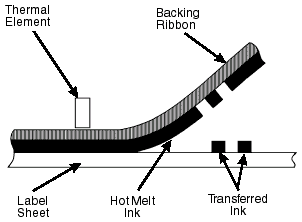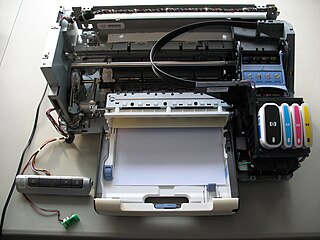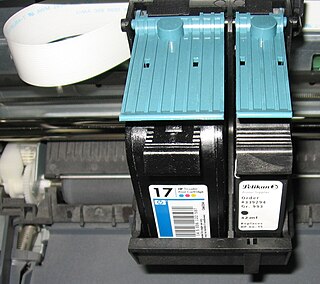
In computing, a printer is a peripheral machine which makes a persistent representation of graphics or text, usually on paper. While most output is human-readable, bar code printers are an example of an expanded use for printers. The different types of printers include 3D printer, inkjet printer, laser printer, thermal printer, etc.

Laser printing is an electrostatic digital printing process. It produces high-quality text and graphics by repeatedly passing a laser beam back and forth over a negatively charged cylinder called a "drum" to define a differentially charged image. The drum then selectively collects electrically charged powdered ink (toner), and transfers the image to paper, which is then heated in order to permanently fuse the text, imagery, or both, to the paper. As with digital photocopiers, laser printers employ a xerographic printing process. Laser printing differs from traditional xerography as implemented in analog photocopiers in that in the latter, the image is formed by reflecting light off an existing document onto the exposed drum.

Inkjet printing is a type of computer printing that recreates a digital image by propelling droplets of ink onto paper and plastic substrates. Inkjet printers are the most commonly used type of printer, and range from small inexpensive consumer models to expensive professional machines.

Dye-sublimation printing is a computer printing technique which uses heat to transfer dye onto materials such as a plastic, card, paper, or fabric. The sublimation name was first applied because the dye was considered to make the transition between the solid and gas states without going through a liquid stage. This understanding of the process was later shown to be incorrect, as there is some liquefying of the dye. Since then, the proper name for the process has become known as dye-diffusion, though this technically-correct term has not supplanted the original name. Many consumer and professional dye-sublimation printers are designed and used for producing photographic prints, ID cards, clothing, and more.

Thermal-transfer printing is a digital printing method in which material is applied to paper by melting a coating of ribbon so that it stays glued to the material on which the print is applied. It contrasts with direct thermal printing, where no ribbon is present in the process.

Toner is a powder mixture used in laser printers and photocopiers to form the printed text and images on the paper, in general through a toner cartridge. Mostly granulated plastic, early mixtures only added carbon powder and iron oxide, however, mixtures have since been developed containing polypropylene, fumed silica, and various minerals for triboelectrification. Toner using plant-derived plastic also exists as an alternative to petroleum plastic. Toner particles are melted by the heat of the fuser, and are thus bonded to the paper.
Lexmark International, Inc. is a privately held American company that manufactures laser printers and imaging products. The company is headquartered in Lexington, Kentucky. Since 2016 it has been jointly owned by a consortium of three Chinese companies: Apex Technology, PAG Asia Capital, and Legend Capital.

MicroDry is a computer printing system developed by the ALPS corporation of Japan. It is a wax/resin-transfer system using individual colored thermal ribbon cartridges, and can print in process color using cyan, magenta, yellow, and black cartridges, as well as such spot-color cartridges as white, metallic silver, and metallic gold, on a wide variety of paper and transparency stock. Certain MicroDry printers can also operate in dye sublimation mode, using special cartridges and paper. ALPS licensed the technology to Citizen and to Okidata. Alps also produced the actual printer hardware and ink ribbon cartridges for those companies.

Seiko Epson Corporation, or simply known as Epson, is a Japanese electronics company and one of the world's largest manufacturers of computer printers, and information and imaging related equipment. Headquartered in Suwa, Nagano, Japan, the company has numerous subsidiaries worldwide and manufactures inkjet, dot matrix and laser printers, scanners, desktop computers, business, multimedia and home theatre projectors, large home theatre televisions, robots and industrial automation equipment, point of sale docket printers and cash registers, laptops, integrated circuits, LCD components and other associated electronic components. It is one of three core companies of the Seiko Group, a name traditionally known for manufacturing Seiko timepieces since its founding.

Kodak EasyShare is a sub brand of Eastman Kodak Company products identifying a consumer photography system of digital cameras, snapshot thermal printers, snapshot thermal printer docks, all-in-one inkjet printers, accessories, camera docks, software, and online print services. The brand was introduced in 2001. The brand is no longer applied to all-in-one inkjet printers or online printing services. Thermal snapshot printers and printer docks product lines have been discontinued. In 2012, Kodak stopped manufacturing and selling all digital cameras and photo frames.

A continuous ink system (CIS), also known as a continuous ink supply system (CISS), a continuous flow system (CFS), an automatic ink refill system (AIRS), a bulk feed ink system (BFIS), or an off-axis ink delivery system (OIDS) is a method for delivering a large volume of liquid ink to a comparatively small inkjet printhead. Many business and professional grade printers incorporate a continuous ink system in their design to increase printing capacity.

An ink cartridge or inkjet cartridge is a component of an inkjet printer that contains the ink that is deposited onto paper during printing.

Solid ink is one technology used in computer printers and multifunction devices. Although originally credited with creation by Tektronix in 1986 it was also credited to Howtek, Inc in 1985. Howtek Solid inks could print millions of colors by subtractive color deposition (layering). The Pixelmaster, a Howtek product, printed with 32 single nozzle inkjets mounted in a rotating reservoir with 8 nozzles per color. It was designed to print on standard sheet paper in 4 minutes with alpha-numeric or images. The Pixelmaster was manufactured by Juki Corporation and sold by Howtek, Inc., Hudson, NH.
Compatible ink is manufactured by third party manufacturers and is designed to work in designated printers without infringing on patents of printer manufacturers. Compatible inks and toners may come in a variety of packaging including sealed plastic wraps or taped plastic wraps. Regardless of packaging, compatible products are generally priced lower than original equipment manufacturer (OEM) brand inks and toners.
Dynamic Cassette International (DCI) is an internationally recognised Boston, Lincolnshire, UK based ink cartridge and laser toner manufacturing company, producing products under the Jet Tec brand name. DCI is the sole UK manufacturer of compatible ink cartridges. DCI is notable for winning the Queen's Award for Enterprise: Innovation in 2004 and the Queen's Award for Export and being one of the biggest employers in Boston, employing over 300 staff at its 40,000 square metres factory. The company is currently Europe's largest manufacturer of compatible inkjet cartridges and has a turnover in excess of £20 million.

Toner refilling is the practice of refilling empty laser printer toner cartridges with new toner powder. This enables the cartridge to be reused, saving the cost of a complete new cartridge and the impact of the waste and disposal of the old one.

A toner cartridge, also called laser toner, is the consumable component of a laser printer. Toner cartridges contain toner powder, a fine, dry mixture of plastic particles, carbon, and black or other coloring agents that make the actual image on the paper. The toner is transferred to paper via an electrostatically charged drum unit, and fused onto the paper by heated rollers during the printing process. It will not stain like ink cartridges, but it can get messy if handled improperly.
Inkjet solar cells are solar cells manufactured by low-cost, high tech methods that use an inkjet printer to lay down the semiconductor material and the electrodes onto a solar cell substrate.
Katun is a supplier of OEM-compatible imaging consumables and supplies for office equipment. Katun designs, manufactures, sells, and distributes OEM-compatible imaging products for copiers, printers, and other imaging equipment worldwide.


















